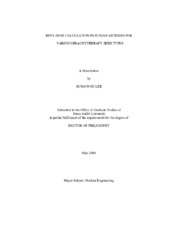| dc.contributor.advisor | Reece, W. Daniel | |
| dc.creator | Lee, Sung-Woo | |
| dc.date.accessioned | 2004-09-30T01:40:47Z | |
| dc.date.available | 2004-09-30T01:40:47Z | |
| dc.date.created | 2003-05 | |
| dc.date.issued | 2004-09-30 | |
| dc.identifier.uri | https://hdl.handle.net/1969.1/42 | |
| dc.description.abstract | This dissertation explores beta dose profile of microspheres packed in arteries, various source geometries of 142Pr that can be used for therapeutic purpose, and dose backscatter factors for selected beta sources.
A novel treatment method by injecting microspheres into feeding arteries of arteriovenous malformation (AVM) is under pre-clinical investigation. To optimize radiation dose to the clinically important area, i.e. arterial wall, preliminary dosimetric studies were needed. Monte Carlo calculations were performed for several geometries simulating arteries filled with microspheres packed by random packing methods. Arterial radii used in the simulation varied from 50 mm to 3 mm; microsphere radii varied from 10 mm to 0.7 mm. Dose varied significantly as a function of microsphere size, for constant arterial sizes. For the same sizes of arteries, significant dose increase was observed because of inter-artery exposure for large arteries (> 0.1 cm rad.) filled with large microspheres (> 0.03 cm rad.). Dose increase between small arteries (0.03 cm rad.) was less significant.
The dose profiles of prototype 142Pr beta brachytherapy sources were calculated using MCNP 4C Monte Carlo code as well as dose point kernel (DPK) for selected cases. Dose profiles were similar to beta sources currently used indicating that 142Pr can substitute for current sources for certain cases and the DPK was closely matched with MCNP result.
Backscattering of electrons is a prominent secondary effect in beta dosimetry. The backscattering is closely correlated with factors such as geometry of source and scattering material, and composition of scattering material. The backscattering factors were calculated for selected beta sources that are currently used as well as potentially useful sources for therapeutic purpose. The factors were calculated as a function of distance from the interface between water and scatterers. These factors were fit by a simple function for future incorporation into a DPK code. Backscattering effect was significant for short distance from the surface of interface between water and scattering material. | en |
| dc.format.extent | 1738890 bytes | en |
| dc.format.extent | 170820 bytes | en |
| dc.format.medium | electronic | en |
| dc.format.mimetype | application/pdf | |
| dc.format.mimetype | text/plain | |
| dc.language.iso | en_US | |
| dc.publisher | Texas A&M University | |
| dc.subject | beta | en |
| dc.subject | AVM | en |
| dc.subject | brachytherapy | en |
| dc.subject | Pr-142 | en |
| dc.subject | dose calculation | en |
| dc.subject | electron | en |
| dc.title | Beta dose calculation in human arteries for various brachytherapy seed types | en |
| dc.type | Book | en |
| dc.type | Thesis | en |
| thesis.degree.department | Nuclear Engineering | en |
| thesis.degree.discipline | Nuclear Engineering | en |
| thesis.degree.grantor | Texas A&M University | en |
| thesis.degree.name | Doctor of Philosophy | en |
| thesis.degree.level | Doctoral | en |
| dc.contributor.committeeMember | Braby, Lesli A. | |
| dc.contributor.committeeMember | Walker, Michael A. | |
| dc.contributor.committeeMember | Berner, Barry M. | |
| dc.contributor.committeeMember | Ford, John R. | |
| dc.type.genre | Electronic Dissertation | en |
| dc.type.material | text | en |
| dc.format.digitalOrigin | born digital | en |


